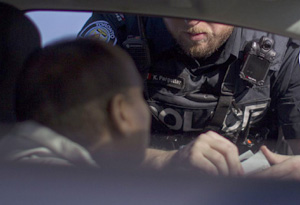Wednesday June 17, 2020 ~ NATIONAL
by Mary Brooke, editor ~ West Shore Voice News
Changing the policing system in Canada so that there is less systemic racism can and should start right away, says NDP Leader Jagmeet Singh.
In a televised press conference today in Ottawa, Singh offered several suggestions for how policing could be changed immediately, to avoid problems that lead to stigmatization and even incarceration of people who — more often than not — are members of disadvantaged, racialized or in some other way of a minority community.
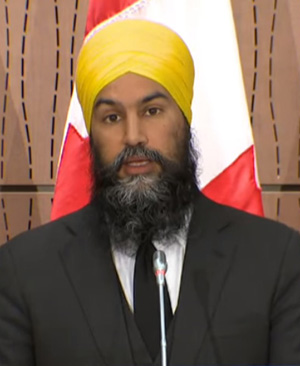
Singh says there needs to be “an entire overhaul of the RCMP — the goal should be to serve and protect people, and the racism needs to be rooted out” including that money should be put toward mental health responses “for the right response in the right circumstances”.
“If there’s the will, there’s a whole host of changes that can be done to address systemic racism,” said Singh this morning. Carding could be ended immediately, says Singh. That’s a process of police pulling over any person at random to make note about their intentions and activities. This is well documented to occur more frequently upon physical appearance including skin colour.
Deescalation (instead of using aggressive commands) is needed more often. There could be a review of the use of force, as to when it is appropriate and when it is not, said Singh. It is thought to not be appropriate for policing administrative offences like driving with an expired licence plate — instead there should just be a ticket or fine. And there could be the removal of minimum jail time for administrative offences, separating criminal from civil.
There are situations where it would be more appropriate (toward a positive outcome for the person) to send a health care worker or social work professional instead of an armed police officer — such as mental health distress incidents and some domestic dispute incidents. Police backup could be available, but dealing first-off with an armed person prepared to use force is repeatedly proving to not be the suitable approach for people with medical or health needs.
As City of Victoria Mayor Lisa Helps said recently, the present system of responding to mental health and other distress calls usually only has police available to do that “at four in the morning”. And certainly the aspect of safety must be taken into account (such as potential violence in a drug situation or domestic scenario) where police officers are the appropriate personnel to attend.
Rethinking the role of policing:
This is the beginning of rethinking the role of police and the idea of response to distress. Officers who are trained to deal with attacks to person and property are probably not the same people best suited to calming down a person with mental distress or assessing medical need.
It’s now evident that for far too long, the behaviours that sometimes manifest from mental illness have been interpreted as aggressive or violent… a professional trained in the areas of mental and emotional health response could deescalate an incident more effectively with the goal of getting a person the help they need.
As is seen now in all the videos of police violence that are surfacing in the USA and Canada, it is evident that some police shift directly to violence and physical apprehension … and too frequently leading to sudden death of the person they are apprehending. As is also seen, this impacts racialized or otherwise disadvantaged persons more than others. In Canada that is recently noted as black and indigenous persons seen as the victims, but the disparity of fair treatment goes well beyond that — with disparity often affecting other racial groups, women and youth.
Dismantling barriers in Canada:
On June 15, Treasury Board President Jean-Yves Duclos says the prime minister wants to move “very quickly” to dismantle barriers that contribute to systemic racism. He said that the federal government is making modest progress at diversifying the federal public service, but there is more work to do, adding that the government can and should help others remove barriers to progress for Canadians of different racial backgrounds by empowering everyone to see the obstacles that others are facing in education, public safety and Indigenous relations, where advances in equity can be made.
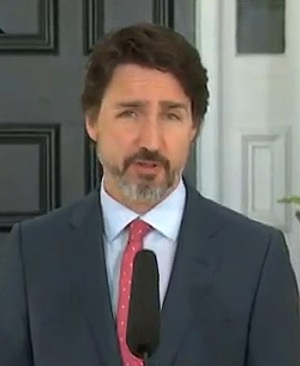
Prime Minister Justin Trudeau said in a news conference on June 13: “Systemic racism is an issue right across the country in all our institutions, including in all our police forces, including in the RCMP. That’s what systemic racism is.”
Trudeau says he has confidence in RCMP Commissioner Brenda Lucky “to make sure to promote inclusion”. Trudeau also said: ” I know that the changes she has already begun to bring to our national police force is going to make a huge difference.” Within a day, Commissioner Lucky was toeing the government line in her comments to media.
Other critics are saying that policy changes can go beyond definitions and be concrete… racial and social basis has been created by particular social beliefs and can be solved by addressing and changing both the beliefs and the systems by which those beliefs are manifested.
The federal Indigenous Affairs Minister Marc Miller has said in recent days that he feels that it’s time to overhaul the policing of indigenous communities so that indigenous communities can police themselves.
The overall thread of change:
People generally feel they should be able to trust police officers to “protect and serve” but the current protests driven by a resurgence of the Black Lives Matter movement have seen some video evidence of how some police operate more within a mode of aggression, threat and even attack.
Addressing anti-racism in BC:

Last week BC Premier John Horgan said — in light of the recent upsurge in aware and protest about systemic racism that his government will be reviewing the Police Act which was last updated 45 years ago.
BC already has in place various anti-racism initiatives, which have been highlighted in the news during the COVID-19 pandemic in light of a spate of anti-Asian racism in BC.
Today in his media briefing, Premier Horgan said that “racism is a scourge, as is COVID-19”, adding that BC had already reinstated the province’s Human Rights Commission before COVID hit.
Policing in the west shore:
Locally on the west shore, various Mayors addressed various issues of this growing region in a panel-style discussion online June 11, chaired by Mitzi Dean, MLA (Esquimalt-Metchosin) and hosted by the Westshore Chamber of Commerce.
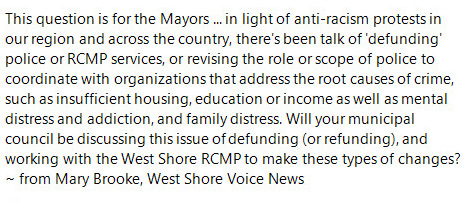
In response to a question posed by West Shore Voice News editor Mary Brooke, all five mayors said their communities are well served by the local West Shore RCMP detachment. But in exploring the issues of what was called ‘defunding’ the RCMP (which is essentially reviewing the role of police):
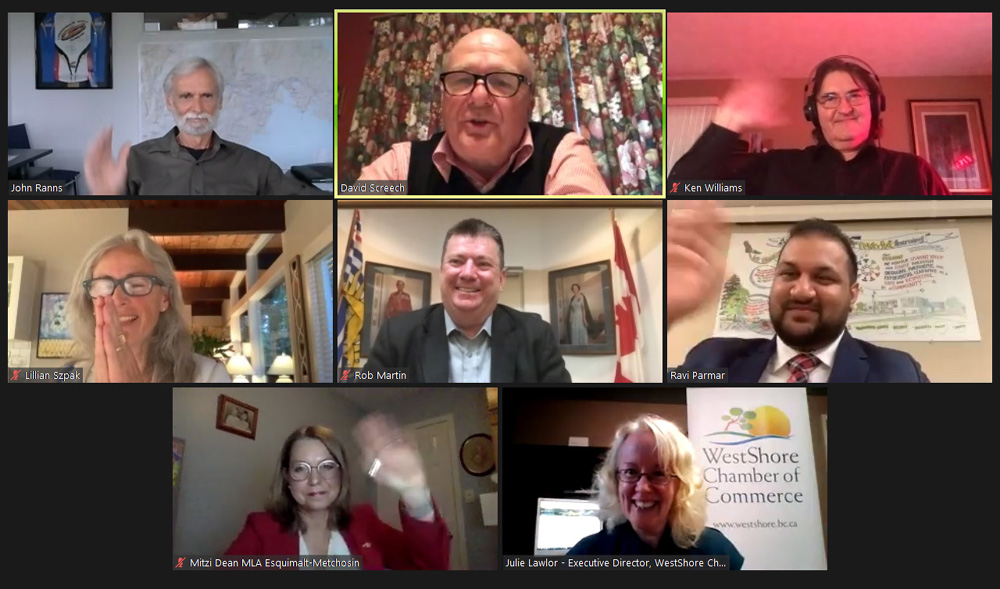
View Royal Mayor David Screech says that in the flurry of current debate about the role of policing that he had reached out to the West Shore RCMP detachment to convey his support for their work. But he also noted that he could see a change in how mental health calls are handled.
Langford Acting Mayor Lillian Szpak said systemic racism does exist but as cultural diversity continues to expand in a growing community that listening and learning could begin a process of healing and inform “restoration and first steps”.
Metchosin Mayor John Ranns says he “takes exception” to the idea of “systemic racism in our community”. He said in elected office now 33 years he has never had any complaints about racism. He feels the current issue is in part a situation of “focusing on problems that aren’t ours”.
Colwood Mayor Rob Martin is supportive of the detachment. He says “racism is based around fear” and that “I see it in my community”. He explained a bit about letters he received from some members of the community in protest about off-reserve housing for indigenous people on Wale Road. “There are places we still need to continue to grow,” said Martin.
Highlands Mayor Ken Williams said he was pleased that his municipality signed on to the Lieutenant Governor’s #DifferentTogether pledge to “uphold the Canadian values of diversity and inclusion and to oppose racism and hate in all its forms”.
In the local school district:
Also speaking during the Westshore Chamber of Commerce panel last week, SD62 School Board Chair Ravi Parmar said “thank you to whoever posed the question” of anti-racism and police. He said that the school district “stands up for all of our people”. He says that people from around the province and the world are moving to the west shore, which is reflected in the school district’s student population of now over 11,000 children and teens.


